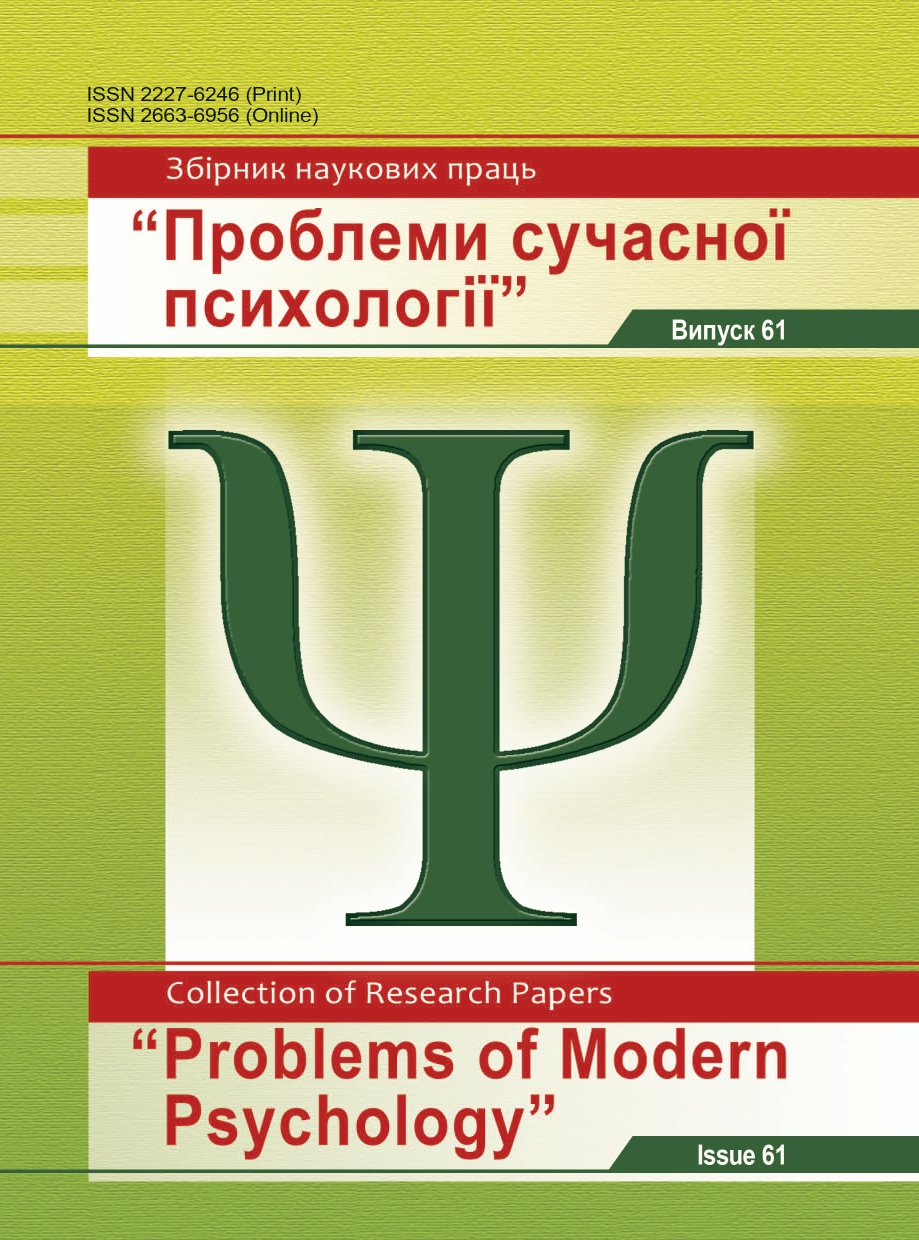Psychological Rehabilitation of Combatants with Mental Disorders and Mental Trauma
DOI:
https://doi.org/10.32626/2227-6246.2023-61.51-73Keywords:
psychological rehabilitation of combatants, mental disorders, mental trauma, chronic constant (or prolonged) stress, acute situational stress, constant physiological stress, psychological stress, violation of the psychological stability, psychological overload, emotional stress, informative stressAbstract
The purpose of this article is to introduce the concept of Psychologicallysomatic stress, to describe types of military stress, to show the principles of use the method of Positive Psychotherapy for psychological rehabilitation of combatants with mental disorders.
Methods of the research. The following theoretical methods of the research were used to solve the tasks formulated in the article: a categorical method, structural and functional methods, the methods of the analysis, systematization, modeling, generalization. The experimental method was the method of organizing empirical research. We also used the method of Positive Psychotherapy.
The results of the research. According to combatants we distinguish the following types of stress: Chronic constant (or prolonged) stress. It is determined by a constant (or prolonged) serious load on a person and causes increased neuropsychological and physiological tension of the body. Acute situational stress is caused by a certain event or phenomenon, as a result of which a person loses his/her mental balance. Constant physiological stress is associated with physical overloads of the body and the influence of various harmful environmental factors on it (uncomfortable temperature, high noise level, etc.). Psychological stress is a consequence of: violation of the psychological stability of the person (for example, affected self-esteem, negative reasons of war, etc.); psychological overload of the person (increased responsibility, large amount of war destroyed activity, etc.). The subtype of Psychological stress is the Emotional stress, that occurs when there is a threat, danger or fear. Informative stress is determined by information overload or information vacuum.
Conclusions. The solution of the problem by using the method of Positive Psychotherapy has to be in such a way, that torments, the patient must always go through five main stages: 1. Looking at the situation from a distance. 2. Careful study of each individual detail, without exception, all the nuances. 3. Situational agreements. 4. Verbalization. In Psychology, this is the formalization of feelings and emotions into verbal-logical forms. In simple words, this is a description of how a person feels when he/she is thinking about a problem. 5. Expanding boundaries, setting new goals and drawing up a plan of the action. The main goal of each session is to free a person from the burden with which he/she came. And you need to do it right now, at the current moment in time. Interestingly, according to this scheme, specialists in Positive Psychology build communication with absolutely all their clients, regardless of their problem.
Downloads
Published
How to Cite
Issue
Section
License
Copyright (c) 2023 Kharchenko Yevhen, Onufriieva Liana

This work is licensed under a Creative Commons Attribution-NonCommercial 4.0 International License.
Copyright
The Editorial Board has the full right to publish original scientific papers containing results of theoretical and experimental research works which are not currently subject to review for publication in other scientific editions. The Author shall transfer to the editorial board of the Collection the right to spread the electronic version of the paper, as well as the electronic version of the paper translated into English (for papers originally submitted in Ukrainian and Russian) by all kinds of electronic means (placement at the official website of the Collection, electronic databases, repositories etc).
The Author of an article reserves the right to use materials of the paper, without approval with the editorial board and the founders of this Collection: a) partially or fully, for educational purposes; b) for writing own dissertation papers; c) for preparation of abstracts, conference reports and presentations.
The Author of an article can place electronic copies of the paper (including the final electronic version downloaded from the official website of the Collection) at:
- personal web resources of all Authors (websites, webpages, blogs etc.);
- web resources of the institutions where the Authors are employed (including electronic institutional repositories);
- non-profit public access web resources (for example, arXiv.org).
But in all cases, it is obligatory to have a bibliographic reference to the paper, or a hyperlink to its electronic copy placed at the official website of this Collection.






